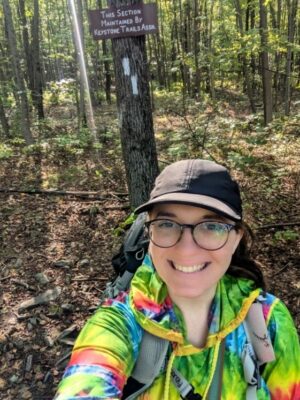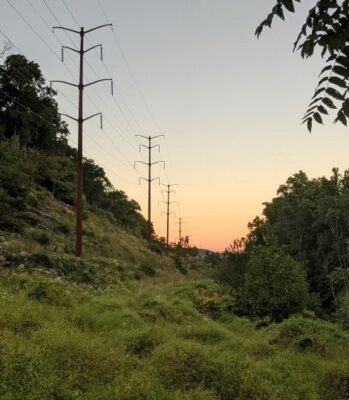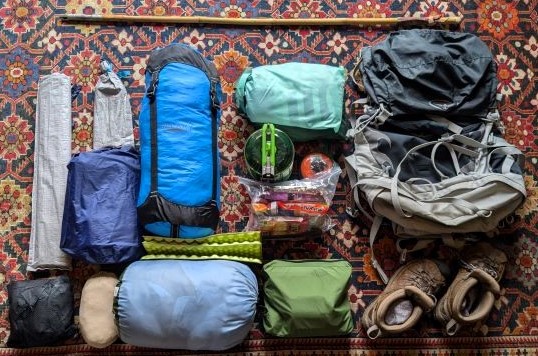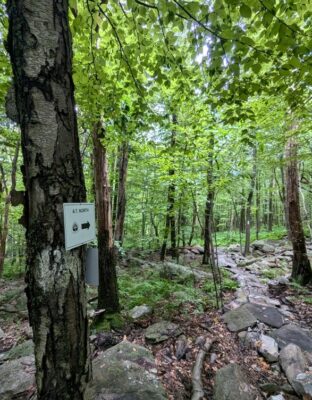by Sam Randall
Right around the time I made the exciting professional move from grad school to begin my fellowship with E4TheFuture, I was simultaneously embarking on a personal journey to break into the next level of outdoor exploration and learn how to become an overnight backpacker.
Between the hours I’ve spent on the trail learning to backpack and the hours spent on the clock learning about energy efficiency policy, a clear analogy presented itself: The principles that make a backpacking trip successful can offer some surprisingly insightful overlap with the principles of energy efficiency.
From Trail to Grid: Where’s the Overlap?
With just a little bit of digging, I’ve found that backpacking offers quite a few valuable lessons that can serve as analogies for energy efficiency.

Backpacking is a type of outdoor recreation that blends hiking and backcountry camping by requiring you to carry all essentials for survival on your back.
Energy efficiency, as a general concept, is simply the use of less energy to perform the same task or produce the same result.
Shared lessons I learned:
 .
.Every Ounce Matters
One of the very first lessons I learned about backpacking was to pack light and only carry what is essential. All the experienced backpackers told me the same thing: every ounce matters and an unnecessarily heavy pack can be the make-or-break of a backpacking trip.
Similarly, in energy use, reducing waste is crucial. Just as unnecessary items add weight to a backpack, wasted energy (through inefficient appliances, poor insulation, etc.) adds load to energy consumption which stresses the power grid and can lead to outages, higher prices, and other undesirable outcomes. Streamlining energy use by optimizing appliances and systems is like packing only the essentials.
Backpacking Lesson: Only bring what you need.
Energy Efficiency Lesson: Only use what is essential.
The Right Gear is Worth It
A major hurdle I’ve faced getting into backpacking has been getting lost in all the gear options out there, the hefty prices, and the strong opinions that come along with what to buy.

I quickly learned that the right gear makes all the difference for an enjoyable trip. A lightweight, durable tent or a well-designed backpack might cost more upfront, but they’re worth the investment in the long run.
It’s the same in energy efficiency — investing in efficient technologies like heat pumps (for buildings) or advanced conductors (for the power grid) can seem expensive at first, but the long-term savings in both energy use and environmental impact make up for those costs. Just like buying the right backpacking equipment means I’ll be better prepared for future trips, adopting efficient technologies today sets us up for a more sustainable future.
Backpacking Lesson: Invest in quality, multi-functional gear. Quality gear is worth the upfront cost.
Energy Efficiency Lesson: Investing in energy efficient technologies pays off long-term.
Leave No Trace (LNT)
The golden rule of all outdoor recreation is to follow the Leave No Trace principles. Those seven principles become the rule of law out on the trail when backpacking so they deserve their own lesson. The basic definition for LNT is to carry out everything you bring in and minimize your impact on the environment.
Energy efficiency mirrors this LNT philosophy because it is about ensuring our energy use has minimal impact on the planet, leaving the environment healthier for future generations. Energy efficiency at the core is about using less energy and that is essential in the fight against climate change because traditional power plants burn fossil fuels that release greenhouse gases and contribute to air pollution. EE reduces fossil fuel use which results in cleaner air, water, and land for all.
Backpacking Lesson: Pack in, pack out, and leave no trace.
Energy Efficiency Lesson: Design energy use to leave minimal impact.
Backpackers understand firsthand the need to protect natural spaces from environmental harm. By sharing our experiences and advocating for policies that promote renewable energy, reduce emissions, and improve energy efficiency, backpackers can help push for systemic changes that ensure the protection of the wilderness we love. Whether it’s participating in policy discussions, supporting clean energy initiatives, or simply spreading the word, we can take the lessons learned from the trail and apply them to the broader conversation about energy and sustainability. Conclusion: Packing Out Just as backpackers seek to travel lightly and efficiently while minimizing their impact, energy efficiency focuses on minimizing consumption and waste while maximizing effectiveness. When done well, both lead to sustainable success — whether that’s an enjoyable trek through the wilderness or a country that efficiently powers its future with minimal environmental impact. So alongside flexing my creative muscles, writing this blog and exploring this fun analogy has allowed me to envision a future where outdoor enthusiasts lead by example in advancing smart energy policies to ensure the preservation of natural spaces and clean energy for all. –Sam Randall is a Policy Fellow at E4TheFuture
As a group that holds a deep and profoundly interconnected relationship with nature, I want to take a moment to “call in” my fellow backpackers. Alongside comparing how the lessons I learned about backpacking could be applied to energy efficiency, I also realized that backpackers themselves are uniquely positioned to be advocates for smarter energy use.

As I continue learning about both backpacking and energy efficiency, I’m excited to see more and more how these two worlds overlap. Both require careful planning, the right tools, and a willingness to adapt to changing circumstances.
All photos: Sam Randall
